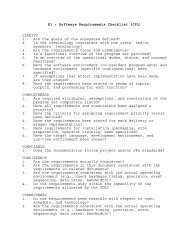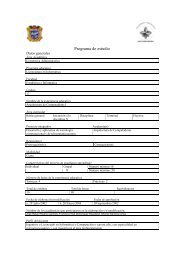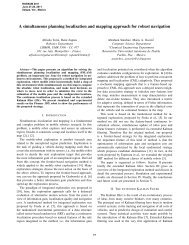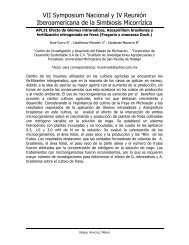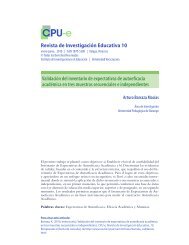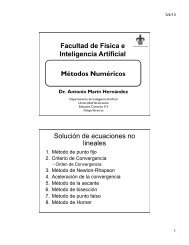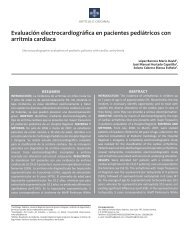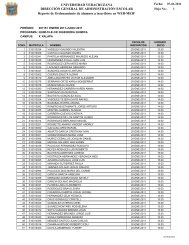Understanding the Software Options
Understanding the Software Options
Understanding the Software Options
You also want an ePaper? Increase the reach of your titles
YUMPU automatically turns print PDFs into web optimized ePapers that Google loves.
TABLE 7. PURCHASE COST (C PCS) OF VESSELS<br />
All vessel pressures less than 10 barg except CS1-V-101 with pressure = 60 barg<br />
Vessel – horizontal CapCost DFP CCEP<br />
Dia.,<br />
m<br />
Length,<br />
m<br />
of a centrifugal pump in CCEP depends<br />
on an additional factor: <strong>the</strong> stages and<br />
split-case orientation. For lower-power<br />
pumps (up to 55 kW and flowrates up<br />
to 57 L/s), <strong>the</strong> pump is operating in<br />
one stage and vertical split case, and<br />
<strong>the</strong> cost is lower. For higher power and<br />
flowrates, <strong>the</strong> pump operates in two or<br />
more stages and horizontal split case,<br />
and <strong>the</strong> cost is higher. Hence, a jump is<br />
observed for <strong>the</strong> CCEP cost in Figure 4<br />
due to <strong>the</strong> change of stages. The CCEP<br />
program warns <strong>the</strong> user if <strong>the</strong> pump is<br />
not operating in <strong>the</strong> appropriate stage.<br />
When C TM for reciprocating pumps<br />
is plotted against shaft power, EconExpert<br />
gives <strong>the</strong> highest cost of <strong>the</strong> four<br />
programs, followed by CapCost and<br />
CCEP, while AspenPEA predicts <strong>the</strong><br />
lowest (reciprocating pumps are not<br />
available in DFP). This result is similar<br />
to what is observed in case studies.<br />
Towers<br />
Towers are vertical-pressure vessels<br />
for separation operations, such as absorption,<br />
distillation and stripping.<br />
They contain trays or packing, plus<br />
manholes and nozzles. For both towers<br />
and vessels, shell thickness is required<br />
for cost estimation in DFP. Since in<br />
most cases, <strong>the</strong> designed pressure is<br />
provided in <strong>the</strong> equipment data, <strong>the</strong><br />
EconExpert<br />
Aspen-<br />
PEA<br />
Material<br />
C PCS ∆% ∆% ∆% ∆%<br />
CS2-V-101 0.9 1.4 CS 5,014 155%* 372%* 1% 21%*<br />
CS6-V-101 1.2 3.5 CS 9,212 308%* 188%* 1% 89%<br />
CS5-V-102/103 1.3 3.9 CS 10,603 52% 183% 2% 105%<br />
CS1-V-102 1.6 4.7 CS 14,490 38% 87% 4% 78%<br />
CS1-V-101 2.7 8.0 CS 38,640 –10% 93% –4% 14%<br />
CS6-V-103 1.3 3.9 SS 10,787 552%* 180%* 2% 104%<br />
CS4-V-101 1.7 6.9 SS 9,718 173% 345% 5% 111%<br />
CS7-VS-105 2.0 3.2 SS 15,295 44% 189% 27% 80%<br />
CS7-VS-106 2.5 6.1 SS 29,670 19% 135% 30% 43%<br />
CS6-V-102<br />
Vessel – vertical<br />
4.4 13.2 SS 136,850 260% –14% –45% –28%<br />
CS2-V-102 0.9 3.7 CS 6,992 629% 441%* 102% 40%*<br />
CS3-V-101 1.8 3.7 CS 15,985 12% 191% 58% 72%<br />
CS5-V-101 2.5 7.4 CS 40,135 –14% 130% 35% 17%<br />
CS5-V-104 4.0 34.5 CS 386,400 –56% –13% –31% –27%<br />
CS7-V-102 0.4 6.0 SS 4,025 291% 923%* 276% 151%<br />
CS7-VS-102 0.5 1.0 SS 2,841 430%* 1301%* 71%* 127%<br />
CS7-V-101 0.5 5.0 SS 4,761 238% 765%* 194% 144%<br />
CS7-VS-104 1.2 1.8 SS 6,348 141% 527% 11% 56%<br />
CS7-VS-103 1.5 2.0 SS 8,591 93% 414% 17% 26%<br />
CS7-VS-101<br />
Vessel – jacketed<br />
3.5 10.5 SS 97,405 –44% 85% –15% –54%<br />
CS7-VS-110 2.0 3.8 SS 59,300+ n/a +<br />
n/a +<br />
n/a +<br />
n/a +<br />
CS7-VS-109 2.3 4.5 SS 75,600+ n/a +<br />
n/a +<br />
n/a +<br />
n/a +<br />
CS7-VS-108 3.0 4.8 SS 124,500+ n/a +<br />
n/a +<br />
n/a +<br />
n/a +<br />
CS7-VS-107 3.2 8.5 SS 199,100+ n/a +<br />
n/a +<br />
n/a +<br />
n/a +<br />
*cost of minimum size as size is less than <strong>the</strong> minimum size<br />
+<br />
not available in this program and so taken from ano<strong>the</strong>r program<br />
following equation from Ref. 1 is used<br />
to estimate <strong>the</strong> shell thickness.<br />
t = [PD ÷ (2Smax E – 1.2P) + CA] (10)<br />
Here, t is <strong>the</strong> shell thickness in meters,<br />
P is <strong>the</strong> design pressure in bars, D is<br />
<strong>the</strong> diameter of <strong>the</strong> vessel (meters),<br />
Smax is <strong>the</strong> maximum allowable working<br />
pressure of <strong>the</strong> material (bars), E<br />
is <strong>the</strong> weld efficiency and CA is <strong>the</strong><br />
corrosion allowance (0.0035 m).<br />
For tray towers, <strong>the</strong> purchase cost<br />
given in EconExpert does not include<br />
trays and packing, while those<br />
are included in <strong>the</strong> total module cost.<br />
Hence, EconExpert’s purchase cost is<br />
not compared with CapCost (Table<br />
6). DFP gives a purchase cost similar<br />
to CapCost, whereas CCEP is higher<br />
when <strong>the</strong> diameter is small (or lower<br />
when large). When <strong>the</strong> total module<br />
cost of <strong>the</strong> tower is compared, for towers<br />
of large diameter, all programs give<br />
similar results (online table V). CCEP<br />
shows a relatively higher total module<br />
cost (+59%). For small-dia. towers,<br />
CapCost predicts a much lower cost<br />
than <strong>the</strong> o<strong>the</strong>rs. A packed tower is also<br />
evaluated (Table 6). CapCost predicts<br />
a much lower cost than <strong>the</strong> rest. Both<br />
CCEP and AspenPEA predict <strong>the</strong> cost<br />
of this packed tower to be significantly<br />
higher than that by CapCost.<br />
Vessels<br />
Vessels are used in chemical processing<br />
plants as reflux drums, flash<br />
drums, knock-out drums, settlers,<br />
chemical reactors, mixing vessels and<br />
storage drums. In general, for horizontal<br />
vessels with low design pressure<br />
and small diameter, CapCost and<br />
EconExpert predict similar purchase<br />
and total module costs while <strong>the</strong> o<strong>the</strong>rs<br />
give much higher costs (Table 7).<br />
For horizontal vessels of large diameter,<br />
CapCost, DFP and EconExpert<br />
give similar results, while CCEP predicts<br />
a higher cost. The total module<br />
cost in AspenPEA is exceptionally<br />
high due to <strong>the</strong> high instrumentation<br />
cost, which is three times CPCS. This<br />
contributes to CTM as ten times CPCS (online table VI).<br />
For vertical vessels, CapCost gives<br />
significantly lower costs than <strong>the</strong> o<strong>the</strong>r<br />
four programs. However, when <strong>the</strong> design<br />
pressure of <strong>the</strong> vessel is very high<br />
(CS1-V-101), CapCost predicts a very<br />
high pressure factor according to:<br />
log10 FP = C1 + C2 log10P + C3(log10P) 2<br />
(11)<br />
where C1, C2 and C3 are constants<br />
that can be found in Ref. 1. Hence,<br />
although <strong>the</strong> purchase cost from Cap-<br />
Cost is comparable or even lower than<br />
in o<strong>the</strong>r programs, <strong>the</strong> total module<br />
cost in CapCost is much higher than<br />
that by <strong>the</strong> o<strong>the</strong>r four programs.<br />
The plot of total module cost of horizontal<br />
vessels against volume (Figure<br />
5) shows that CapCost and EconExpert<br />
predict similar total module costs<br />
for horizontal vessels. DFP predicts a<br />
slightly higher cost, whereas Aspen-<br />
PEA and CCEP predict <strong>the</strong> highest<br />
costs. Also, CCEP’s cost of horizontal<br />
vessels increases faster with increasing<br />
volume than that by AspenPEA.<br />
When volume is large, CCEP predicts a<br />
much higher cost than AspenPEA, and<br />
<strong>the</strong> deviation becomes more significant<br />
as <strong>the</strong> volume and size increase. The<br />
horizontal vessels evaluated in <strong>the</strong> case<br />
studies are all below 100 m3 (Table 7),<br />
and <strong>the</strong>ir costs follow <strong>the</strong>se trends.<br />
For vertical vessels of small diameter,<br />
CapCost predicts lower purchase<br />
and total module costs than <strong>the</strong> o<strong>the</strong>rs<br />
(Figure 6, Table 7 and online table VI).<br />
However, for large-diameter vertical<br />
vessels (CS7-VS-101), <strong>the</strong> cost given<br />
CHEMICAL ENGINEERING WWW.CHE.COM AUGUST 2011 27



